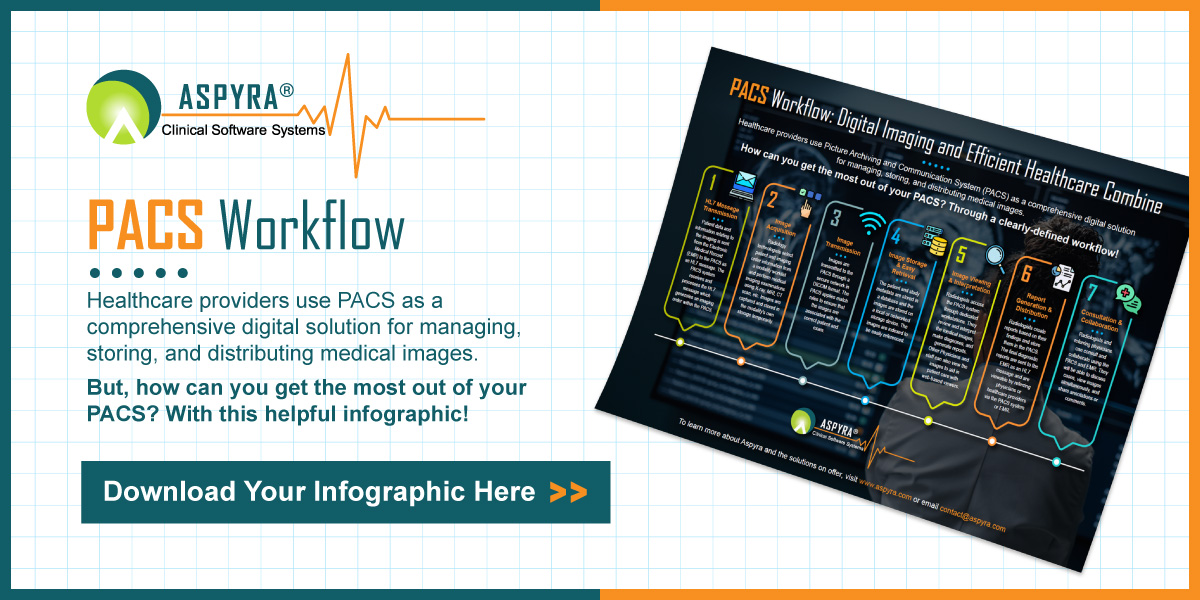How PACS Transforms Medical Imaging Workflow

Quality healthcare requires quality medical imaging to give practitioners a full view of what treatments their patients need. With the steadily increasing number of scans and tests, Medical CIOs and IT experts have also noticed that doctors require better IT solutions to determine the right course of care. One solution that enhances medical imaging is PACS. Though typically used in radiology, PACS imaging may not only improve the quality of medical images, but also the distribution and management of images within the professional network.
An Overview of PACS
A Picture Archiving and Communication System—better known as PACS—is the system many medical specialists rely on to access the digitally stored images and reports collected from tests to help diagnose patients. Radiologists use PACS to store X-ray images, which can then be transferred to other doctors working on the same patient through the Digital Image and Communication in Medicine (DICOM) platform.
PACS Improvement of Medical Imaging
PACS offers a wide range of benefits to physicians who need quality medical imaging to make accurate diagnoses. Below is an examination of what benefits PACS offers to doctors for sharing, reviewing, and compiling medical images on a daily basis:
Optimal Viewing
PACS improves medical imaging by providing physicians with a high degree of digital imaging tools to enhance and view images with more detail. Zoom and brightness tools enable practitioners to focus on specific areas of the scan or increase brightness to help determine the measurements of growths or cellular masses within the body. For a better perspective of the scanned area, rotational tools also allow medical images to be adjusted to certain angles.
PACS also offers tools to mark or measure images. Medical images that lack measurements following an examination could cause confusion for the final diagnosis; thus, having the ability to add measurements to medical images post-exam is invaluable to medical experts. Furthermore, medical imaging annotations allow easier collaboration and communication between professionals if notes on the image are present.
Better Management of Medical Data
Through PACS, medical imaging becomes much easier to share or access between medical experts. Since it’s system utilizes cloud storage to store medical data, doctors need only access the network and pull up the record history to find whatever patient reports they need at the time. Using this system, doctors across the country can exchange vital medical images with fellow professionals, giving a complete view of the patient’s overall health. Quick, convenient and efficient, PACS can transfer medical imaging data across different healthcare facilities, so long as the contacted facility maintains a secure VPN connection. This secure data exchange will thus follow HIPAA guidelines and inform physicians’ decision-making for each patient’s treatment regimen.
Streamlined Workflow
Time is a key factor to ensuring optimal patient care and wellbeing. With the volume of patients being tested, scanned, and examined daily, there is little room to delay reports when an individual’s physical health is in jeopardy. Hence, having an efficient medical imaging workflow is essential for medical professionals with limited time to ensure an accurate diagnosis. PACS streamlines the exchange and review of medical images across various medical practices.
Interfacing with other systems—such as EMR Critical Reporting or PACS’ automated tasks capabilities—enable doctors to automatically send reports to multiple locations once they are signed. Primary care, attending, and specialist physicians are then able to immediately access their patient’s diagnostic images and reports when needed. Through this system, medical imaging workflow is streamlined, significantly cutting time spent on diagnoses for physicians so they can prioritize their patients. An additional function that improves medical imaging workflow is the ability to mark report results with critical importance. When a patient’s condition relies on quick test results, PACS automated intelligence can flag the report as urgent, thereby cutting time on treatment and ensuring the results are rushed to physicians.
Improve Medical Imaging Workflow with Aspyra
Beyond radiology, PACS helps medical practitioners streamline their medical imaging workflow through collaboration, task automation, and image customization options. Easy to use and install, Aspyra’s PACS solutions provide medical professionals with the essential tools they need to examine reports, share insights with fellow experts, and quickly treat patients with the utmost care and accuracy. Contact one of our team members now to learn more about Aspyra’s PACS solutions and offerings.

